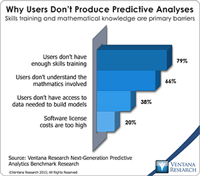Predictive analytics is a rewarding yet challenging subject. In our benchmark research on next-generation predictive analytics at least half the participants reported that predictive analytics allows them to achieve competitive advantage (57%) and create new revenue opportunities (50%). Yet even more participants said that users of predictive analytics don’t have enough skills training to produce their own analyses (79%) and don’t understand the mathematics involved (66%). (In the term...
Read More
Topics:
Data Science,
Business Analytics,
Business Intelligence,
Business Performance,
Cloud Computing,
Uncategorized
Qlik helped pioneer the visual discovery market with its QlikView product. In some respects, Qlik and its competitors also spawned the self-service trend rippling through the analytics market today. Their aim was to enable business users to perform analytics for themselves rather than building a product with the perfect set of features for IT. After establishing success with end users the company began to address more of the concerns of IT, eventually creating a robust enterprise-grade...
Read More
Topics:
Analytics,
Business Analytics,
Business Collaboration,
Business Intelligence,
Cloud Computing,
Data Preparation,
Information Management,
Uncategorized,
Visualization,
Qlik,
Qlik Sense












